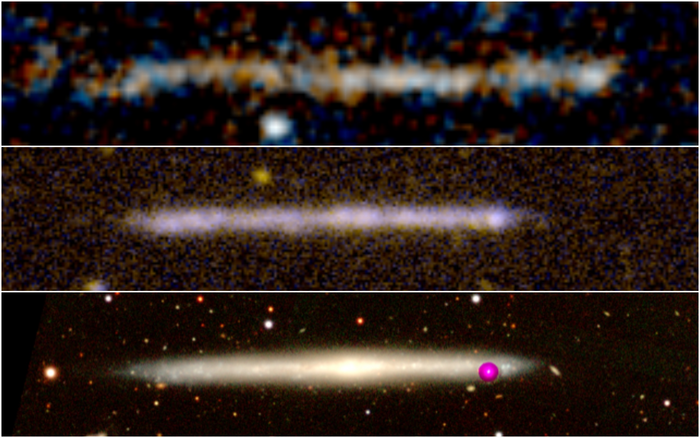‘Runaway supermassive black hole’ mystery solved: Scientists find new explanation for unusual star structure
Identification is a ‘pity’ in one respect, researcher says

Scientists think they have found an explanation for what scientists thought was a “runaway” black hole speeding through the universe.
Last month, scientists reported that they had seen what appeared to be an object unlike anything seen before. What originally appeared to be scratches on Hubble images was actually a black hole that had been thrown out from its home galaxy and was now speeding through the cosmos, scientists said.
Astronomers had come to that conclusion after spotting a long trail of stars, formed 8 billion years ago. It was a stretched out, narrow shape, roughly the same size as our own Milky Way.
Last month’s study suggested that those stars were the wake left behind from that runaway black hole. As the black hole travelled through a gas cloud, it left behind the right conditions to start forming stars, that study suggested.
It was shock and a breakthrough for a number of reasons: it was unprecedented, and required a number of different conditions for it to be true. That led astronomers both to celebrate and question the theory, and in the time since other researchers have been working on their own ideas.
Now scientists at the Instituto de Astrofísica de Canarias (IAC) have suggested their own, more ordinary explanation of the unusual, long star structure. They suggest that it is in fact just a flat or thin galaxy – one without a bulge that makes it wider – that is being seen from its side.
“The motions, the size, and the quantity of stars fits what has been seen in galaxies within the local universe,” saidJorge Sanchez Almeida, an IAC researcher who is the first author of the article, in a statement.
“It’s a relief to have found the solution to this mystery, the new proposed scenario is much simpler. In one sense it is also a pity, because the existence of fleeing black holes is expected, and this could have been the first one to be observed.”
The team compared the mystery structure with another, much better known galaxy, named IC5249. That is near to us, has a similar mass of stars, and doesn’t have a galaxy either.
They found that it was surprisingly similar. The stars were moving in similar ways to those found in closer, comparative galaxies, researchers said.
That led scientists working on the new paper to suggest that it is a relatively normal and expected galaxy, rather than an out-of-control black hole. But they hope that further observations will shed further light on what exactly it is doing – and could still allow the galaxy to prove of interest to astronomers.
“We also looked at the relation between the mass of the assumed galaxy and its maximum velocity of rotation, and discovered that indeed it is a galaxy which behaves like a galaxy,” said Ignacio Trujillo, an IAC researcher who worked on the study. “It is an interesting object, because it is quite a large galaxy at a very large distance from Earth, where the majority of the galaxies are smaller.”
The proposal is reported in a paper, ‘Supermassive black hole wake or bulgeless edge-on galaxy?’, published in the journal Astronomy and Astrophysics.
Subscribe to Independent Premium to bookmark this article
Want to bookmark your favourite articles and stories to read or reference later? Start your Independent Premium subscription today.

Join our commenting forum
Join thought-provoking conversations, follow other Independent readers and see their replies